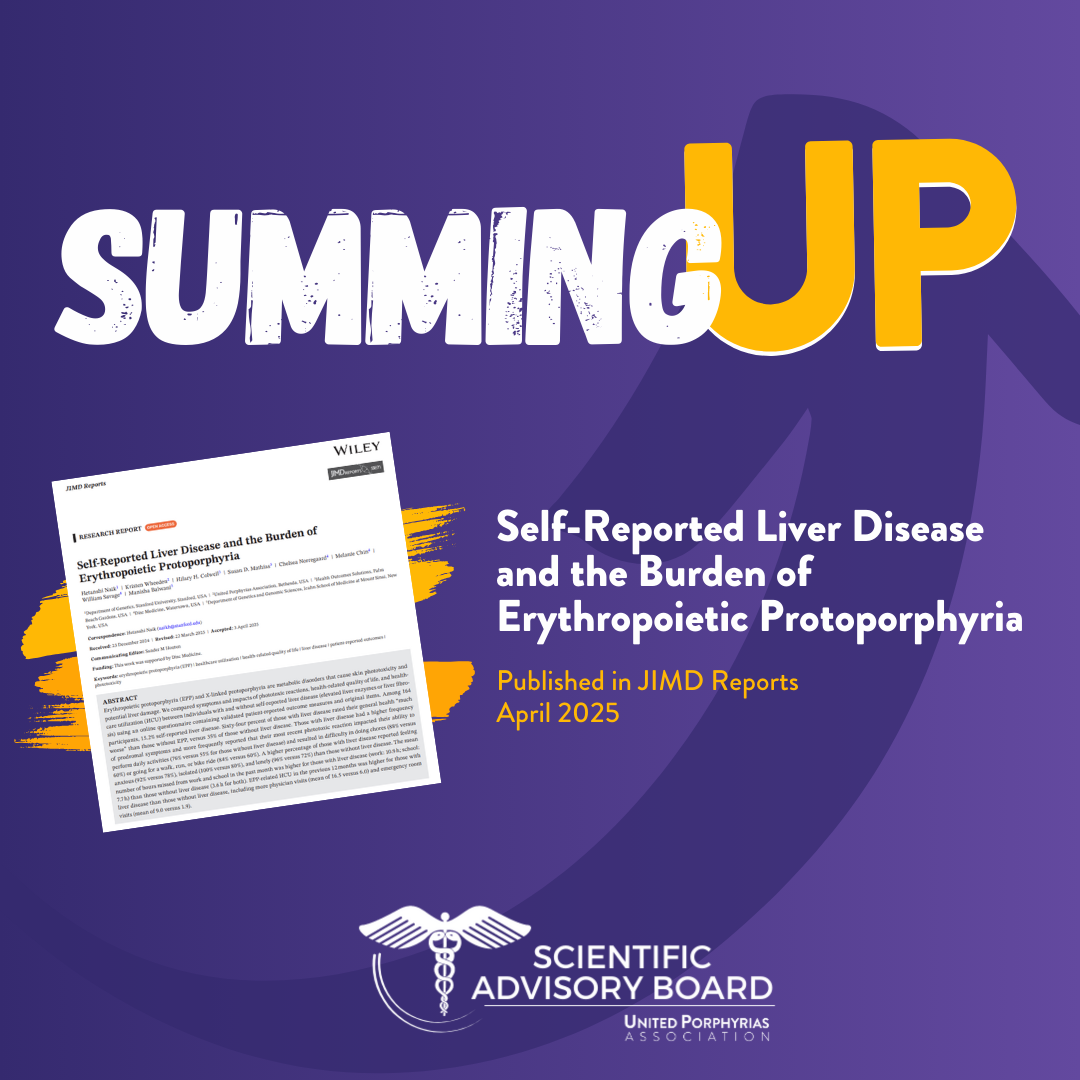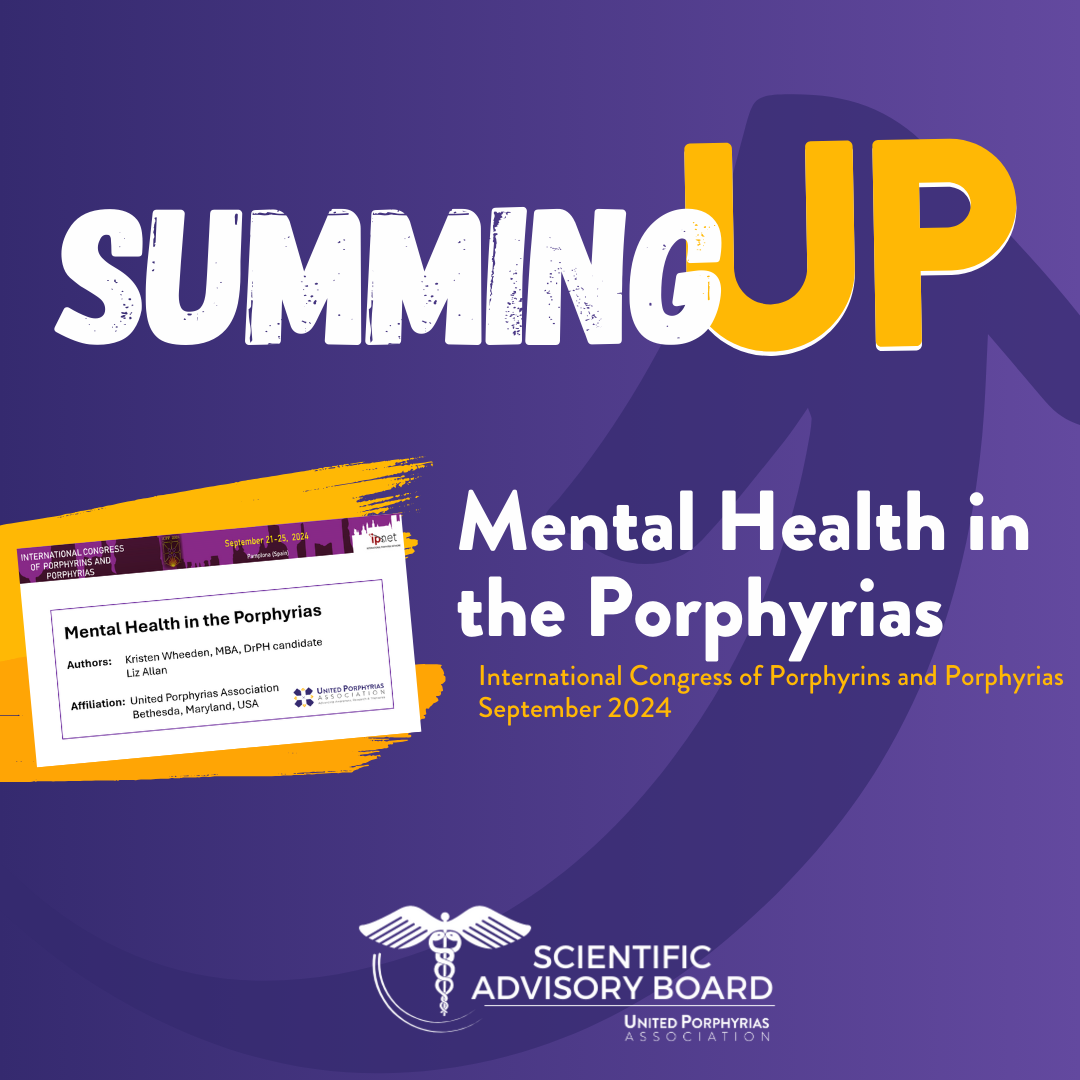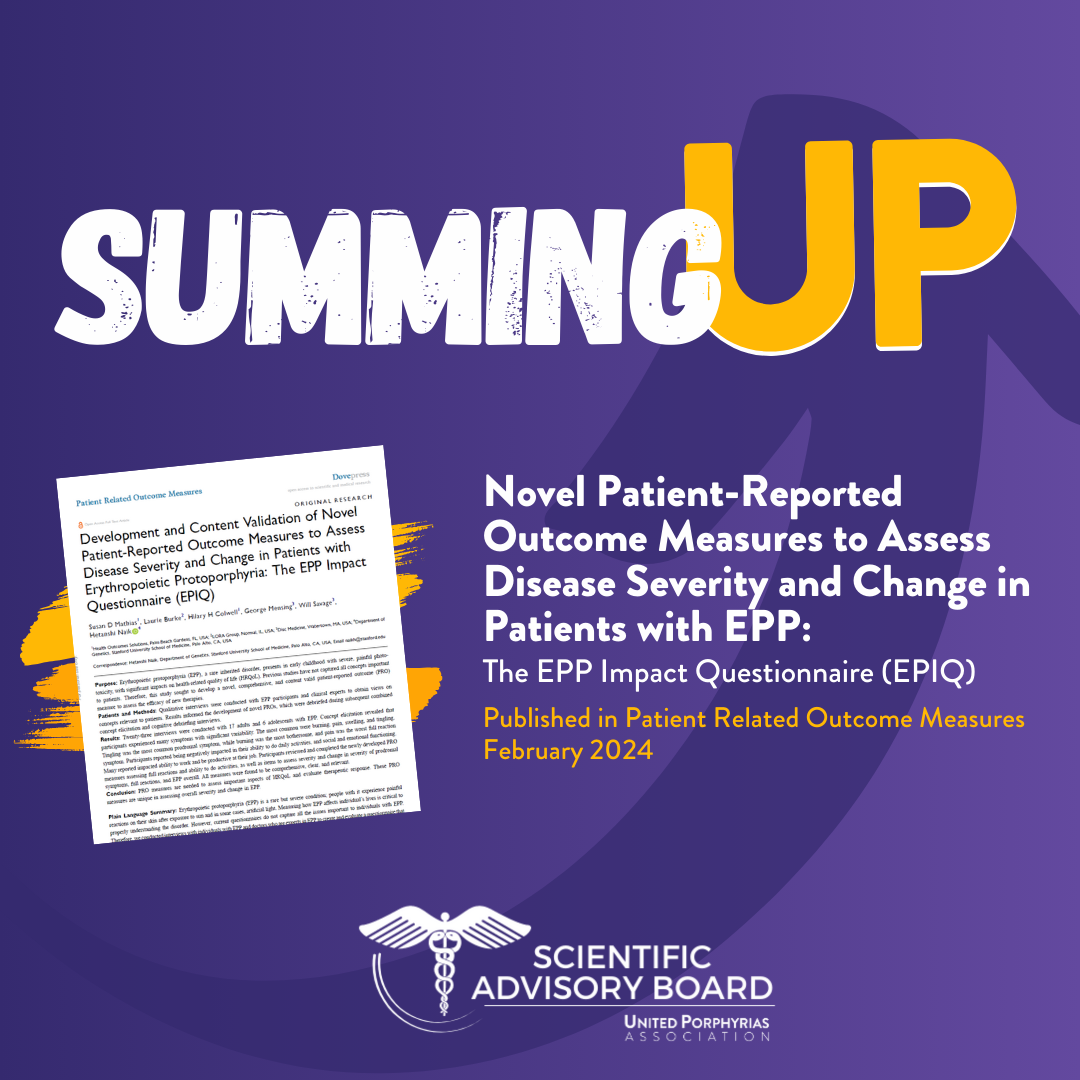EPP/XLP Liver Guidelines
Summing UP features the latest porphyria research in easy-to-understand summaries that have been reviewed and approved by the UPA's Scientific Advisory Board of porphyria experts.
Evidence based consensus guidelines for diagnosis and management of Protoporphyria-Related liver dysfunction in erythropoietic protoporphyria and X-Linked protoporphyria
Published in Hepatology in July 2023
Full article here
These guidelines provide recommendations on diagnosis, monitoring and treatment for liver-related dysfunction in protoporphyrias (EPP and XLP).
How these guidelines were created
These guidelines were created by porphyria experts from the National Institute of Health’s Porphyrias Consortium. A literature review, including cohort studies, case series and case reports related to protoporphyrias was conducted. Subgroups of the experts reviewed the literature and arrived at consensus on recommendations for guidelines on the treatment and management of liver dysfunction in protoporphyrias.
-
Erythropoietic protoporphyria (EPP) and x-linked protoporphyria (XLP) are jointly referred to as the protoporphyrias. Both EPP and XLP are caused by changes to one of the enzymes of the pathway that makes heme- an important molecule in the body. In both types of protoporphyria, a change in one of these enzymes causes an intermediate product called protoporphyrin (PPIX or “protoporphyrin 9”) to accumulate in red blood cells.
PPIX is activated by light in the 400-410 nm wavelength range. These wavelengths are in the blue part of the visible light spectrum. When light from the sun or other sources with this wavelength passes through the outer layer of the skin, it activates the PPIX in the blood and the activated PPIX reacts with surrounding tissues, causing pain and other symptoms.
All protoporphyria patients have painful reactions to light, but there can be other complications and symptoms related to protoporphyria, including vitamin D deficiency, gallstones, anemia, enlarged spleen, and liver disease. While frequency of these other complications is not well known, a small but significant number (1-5% of protoporphyria patients) will develop severe liver disease that may require a liver transplant.
-
Protoporphyria-related liver disease is related to the bile system in the liver. Bile is a substance that helps your body digest and absorb food. Bile is made in the liver and then stored in the gallbladder or passed through the bile ducts to the intestines.
With protoporphyrias, excess PPIX is deposited in the liver, then transported into the bile and intestines, and eliminated with feces . Because PPIX doesn’t dissolve well, it forms crystals in the bile. These crystals can damage or kill cells and impair the formation and flow of bile. Part of the PPIX is reabsorbed from the intestines into the circulation, perpetuating this damaging cycle.
It isn’t clear why some protoporphyria patients develop liver disease, however patients with higher levels of PPIX in their blood, EPP patients with two copies of the strong EPP gene, or males with XLP appear to be at higher risk.
-
Screening is an important part of determining risk and monitoring changes to liver health. The recommended screening tests for patients with protoporphyria who haven’t already been found to have liver disease are:
Liver function tests should be done at diagnosis and annually after that
Genetic testing should be conducted at time of diagnosis to determine if the patient has a genotype that puts them at higher risk.
If liver function is found to be normal, the following precautions are recommended to help protect the liver and bile system:
Maintaining a healthy body weight
Avoiding excessive alcohol intake- one drink per day for females and two per day for males is acceptable. Patients who are at high risk of liver damage are advised to abstain from alcohol.
Getting immunized against hepatitis A and B
Avoiding oral contraception with high estrogen content, as it may also interfere with bile flow. Oral birth control with low estrogen or progesterone-only content, barrier methods or intrauterine devices (IUD) are all considered reasonable alternatives
Protoporphyria patients are at increased risk of gallstones and blockages in the bile ducts compared to the general population. Gallstones should be treated in the same way as they would be for patients without protoporphyria. Gallbladder removal (cholecystectomy) is not recommended if a patient does not have symptoms related to gallstones or bile-duct issues.
Screening ultrasounds are not recommended if the patient has normal liver function and no symptoms of gallstones.
-
If a patient with protoporphyria has signs of liver dysfunction, they should be evaluated to determine if the dysfunction is due to protoporphyria or another condition. Conditions that may be checked for include fatty liver disease, viral and autoimmune hepatitis. Testing to determine the source of liver dysfunction may include bloodwork, ultrasound and/or biopsy.
It is recommended that patients with suspected liver dysfunction due to protoporphyria be referred to a liver specialist familiar with protoporphyria-related liver disease.
If liver dysfunction is related to protoporphyria, tests to measure baseline function should be conducted and monitoring tests should be done every 6 months, or more frequently if needed. Monitoring testing should include liver biochemical tests, complete blood count, blood clotting time and PPIX levels. A baseline ultrasound test is also recommended.
-
Because of the rarity of protoporphyria-related liver disease, it is difficult to study possible treatments. Small studies and case reports suggest that ursodeoxycholic acid (UCDA), colestipol and cholestyramine, and vitamin E may be beneficial. The use of cimetidine and beta-carotene is unclear or untested.
Patients with protoporphyria who have evidence of liver dysfunction or are at increased risk of liver injury (high PPIX, males with XLP, two copies of the strong EPP gene) should avoid alcohol and oral contraceptives with high doses of estrogen.
Anemia is common in protoporphyrias. Anemia refers to conditions where your body is not able to transport enough oxygen. Iron supplementation can help improve anemia, however in EPP it may cause increased light sensitivity and liver damage. Iron supplementation is recommended in EPP only when anemia symptoms are present, and hemoglobin and ferritin levels are low. In XLP, iron supplementation is recommended and may improve symptoms.
-
Protoporphyria-related liver disease can progress to a point where a liver transplant is required. Success rates for protoporphyria-related liver transplants are similar to other liver transplants, and a successful living donor transplant has been performed for a patient with EPP.
With protoporphyria-related liver transplants, there is the potential for a reaction to operating room lights during surgery. Severe burns can occur on the skin and internal organs. To prevent burns special light filters should be used over operating room lights.
With these transplants there is also a higher likelihood of complications related to the biliary system, and so it is suggested that a method called “Roux-en-Y" be used to connect the transplanted liver and the bile ducts.
Liver transplantations are not curative because the excess PPIX comes from the bone marrow (where red blood cells are produced), and there is a chance that over time the transplanted liver will again become damaged by excess PPIX. A bone marrow transplant (“allogenic hematopoietic stem cell transplant”) following the liver transplant prevents liver damage from recurring and eliminates light sensitivity, however it is considered a very risky procedure with a high chance of complications, including death, and so the risks and benefits should be carefully considered.
Before liver transplantation, there are other interventions that may help reduce PPIX in the plasma and minimize liver damage and surgery complications. More research is required to understand if and how these treatments are beneficial. They are:
Therapeutic plasma exchange (TPE): In TPE, your blood is circulated out of your body where the plasma is separated out and replaced with a plasma substitute, and then returned to your body. The goal with this treatment is to reduce the amount of PPIX circulating in your body.
Red blood cell exchange (RCE): RCE is a similar process to TPE, only instead of replacing plasma, your red blood cells are being replaced. The effectiveness of this treatment is uncertain but may be beneficial before a bone marrow transplant to prevent liver injury.
Intravenous hemin therapy: Hemin is a therapy for treating acute hepatic porphyrias. It does not generally help with protoporphyrias, however it has been used in rare situations and may be beneficial in cases of severe liver damage. More studies are needed.
PRBC transfusion: in this procedure, red blood cells from a donor are added to your blood. The goal with this intervention is to reduce your body’s need to make its own red blood cells and therefore reduce the amount of heme and PPIX produced.
-
Researching protoporphyria-related liver disease is challenging because it is so rare. Collaboration between treatment centers is important to gain a better understanding of treatment options. Studies to better understand the risk factors and genetic markers that make the development and progression of liver disease more likely and allow for earlier preventative steps.
Emerging treatments, such as bitopertin, may also help prevent or treat porphyria-related liver disease.
CONTENT REVIEWED BY UNITED PORPHYRIAS ASSOCIATION SCIENTIFIC ADVISORY BOARD






